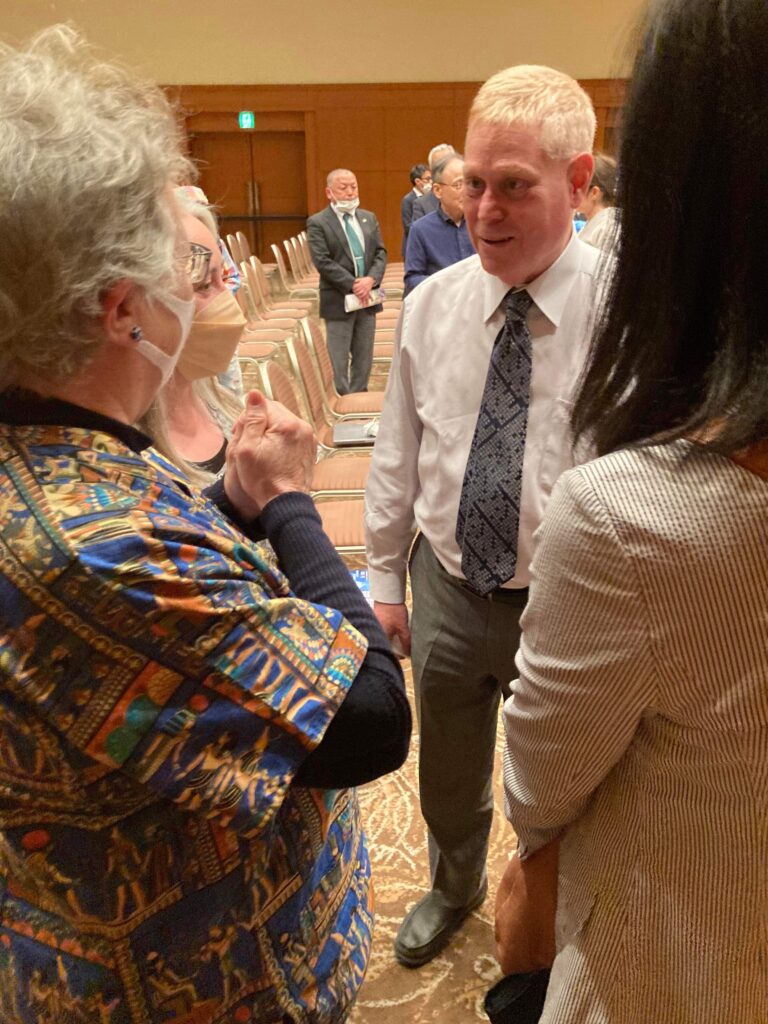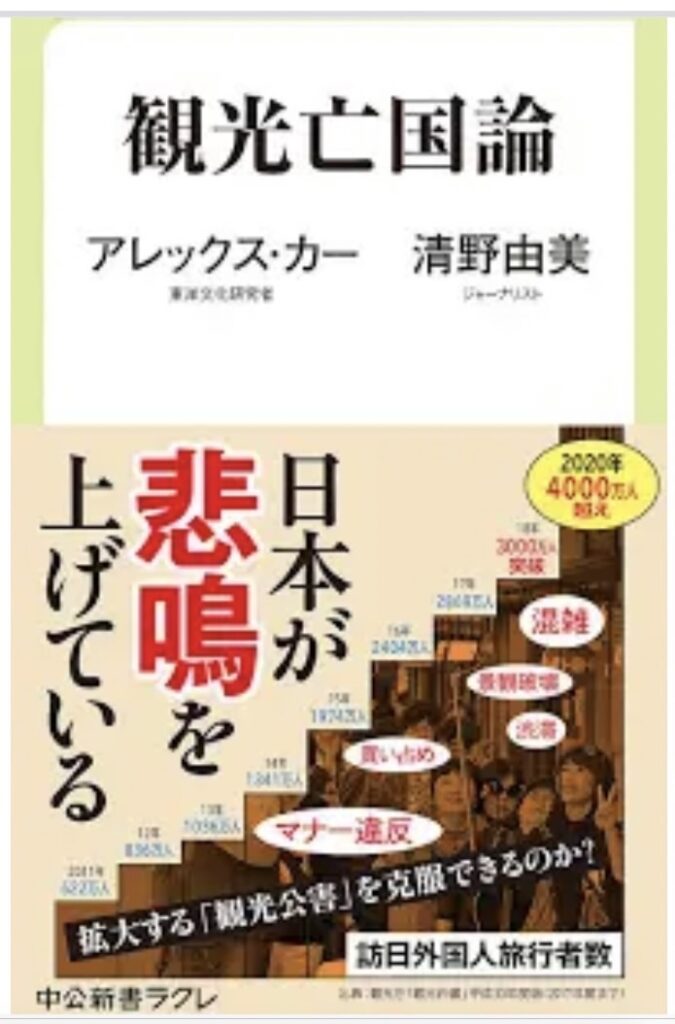REPORT FOR WIK ON ALEX KERR’S TALK (May 10, 2023)
Sponsored by KUAS (Kyoto University of Advanced Science)

A capacity audience was on hand for a talk by Alex Kerr (in Japanese) entitled “Kankou ha Rikkoku ka?” (Will Tourism Lift Up the Country?) at Kyoto Hotel Granvia on May 10. At least three members of WiK were present.
One of our most prestigious members, Alex Kerr wears many hats — expert on things Japanese, promoter of using old buildings, writer of many books in English and Japanese particularly about changes he has seen in the country and its fast-disappearing traditions, and now (from April) professor at KUAS. He was on the panel of the WiK Symposium on Heritage and Tourism in November 2019, at which he made several similar points to the ones he made in this talk. His ideas about the management of tourism in Japan are known from his Japanese-language book Kankou Boukokuron (The Destruction of the Country by Tourism, ). The title is a play on words of the Ministry of Tourism’s 2015 slogan, Kankou Rikkoku (The Uplifting of the Country by Tourism) and the subsequent drastic increase in tourists in the years leading up to 2020.
We all know how that turned out — COVID-19 struck and there was a (blessed) respite during 2020-2022. You could visit Fushimi Inari Shrine and actually see down the empty vermilion corridors of torii gates! Other sections of Kyoto had a dreamlike quality in their emptiness. But no longer. As of 2023, the numbers are right back up where they were before — around the 31 million mark — and during the quiet time, when policies could have been put in train to prepare for the inevitable influx, little was done. Thus Alex’s book, even post-COVID, still has a great deal of relevance, as his talk on this occasion and also his on-stage conversation with Yoshinori Sato, head of the Jinbun Gakubu (humanities department) of KUAS and supervisor of the newly instituted “Tourism course” at the University, attested.
First off, it is important to know that sheer numbers of tourists are not really the issue (many countries have a higher head count) and also PR is not the issue — it is well-known that Japan is at the top of the list for travelers worldwide, with a number of PR-related sites, YouTube videos, etc. What is key now is how to manage the activities of the people who come to Japan, and Kyoto, as tourists.
Alex made the following points:
- Is “convenience” important? If a large parking lot for cars and buses is built right next to an important tourist site, it deprives tourists of the chance to see the traditional road leading up to the site, with its shops and amenities. It seems certain that pedestrians spend more and have a more intimate experience with a place than people in cars or buses. Why not close, say, Shijo Street to traffic once in a while and have a pedestrian-only experience? That was one suggestion. “Convenience” in the form of proximity of parking to sites is not always best.
- Utilizing technology — especially in the form of an online reservation system, such as is practiced in many parts of Europe, to ensure that sites do not become overcrowded and thus provide a less than optimal experience.
- Rethinking the value of the tourist experience (as opposed to the present completely egalitarian method of allowing anyone, in any number, to visit if they have paid a nominal fee). Some sites are worth more, and those who really wish to visit those sites, not necessarily those who just want to take a selfie in front of it, then move on to the next, will pay a more realistic amount to do so. The example given was climbing Mt. Fuji, which presently costs only \1000, and the path is fatally overcrowded. (Alex said that an estimated 90% of people climb this most sacred mountain of Japan without thinking of the sacred aspect at all, but simply because it is the highest mountain in the country. I personally found this appalling.)
Now the tourist market is full of ideas for making things more comfortable, cheaper, and more convenient for the tourist; but what if the opposite was the case? What if people who manage sites think, do we want and need this many tourists? What about the ambiance or atmosphere, which is ruined when too many people are milling around? Perhaps it’s time to think of the content of culture itself. And to revisit the notion of Quality (of the experience) being valued over Quantity (of people coming through the gates).
A corollary to this is the rather unusual viewpoint, put forward by Alex, that as a tourist, one should consider whether the site actually needs one’s visit. To this end, one method would be to have tourists visit comparable sites that perhaps are not featured on every website and YouTube video about Japan, but still offer a great experience and which monetarily need the visit more. (I think everyone who lives in Japan, and especially Kyoto, has their secret “best sites” list, which they share only with good friends.) It isn’t necessary for every temple, shrine, view, etc. to be appropriated by crowds of tourists, but a few more visits to some of them might help these sites immeasurably. - Problem of zero-dollar tourism, in which tourists pay for tours, hotels, meals etc. to people from their own country, not Japan, who run these establishments. No money is transferred to the economy of Japan with this system.
- Various actual examples of issues that Alex feels need to be considered with boots-on-the-ground tourism include:
- Bad signage, including multiple signs that say the same thing (e.g. “Please take off your shoes”) cluttering up the view. Also ugly signage, which is simply not necessary. There are many less intrusive options available.
- How to alert people to the manners appropriate to a site. (I remember in Rome back in the day, women were stopped on the steps of St. Peter’s if their clothing was deemed inappropriate by the monitoring nuns.) Signs that just say “No this, no that” are not effective, even in pictorial form.
- Trees that are pruned and lopped in an ugly manner. This gives a negative impression of the famed Japanese love of nature. (I myself have lobbied for years in local government for better treatment of trees, hedges, etc. which were planted by the government and then mistreated in these ways.)
After a break, Alex was joined on the stage by Yoshinori Sato, to have a conversation about these issues. There was also a Q&A, which was curtailed due to time pressure.
Thanks very much to KUAS for hosting such an important event. I hope very much that ideas coming from such a forward-thinking institution will make a difference to the handling of tourism in Kyoto in the coming months and years. At present, as Prof. Sato said, there is no actual Tourism Department in the University, but he pointed out the necessity of such a department in the future, and Alex agreed. Also, today’s seminar could be extended into a whole series which would provide more of an education on these matters.
Thanks also to Alex Kerr for taking up and making visible some things that probably many more sensitive foreign tourists notice during their visit, and may, if not considered and changed, end up having a deleterious effect on tourism in Japan. There was rueful laughter among the audience members when some of the Powerpoint photos, particularly those of signage and trees, came up on the screen.
This is a matter of national pride in perhaps a manner not always thought of — the real value of these sites and their preservation into the future, not for people who think of Japan as a large version of Disneyland, but for those, including Japanese people, who love and value this country and culture and their place in the world.

